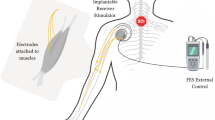Abstract
Motor imagery can stimulate the same neuroplastic mechanisms of the brain as their actual execution. The motor imagery can be controlled via the brain–computer interface (BCI), which transforms the EEG signals of the brain appearing during the motor imagery into commands for the external device. The results of the two-stage study of the application of a non-invasive BCI for the rehabilitation of patients with marked hemiparesis resulted from a local brain injury. We have shown that the learning to manage the BCI does not depend on the duration of disease, localization of the damaged site, and the severity of neurological deficit. The results of the first stage of the study carried out in a group of 36 patients showed that the rehabilitation therapy was more effective in the group that was trained to manage the BCI (the ARAT score improved from 1 [0; 2] to 5 [0; 16], p = 0.012 in the BCI group; no significant improvement was detected in the control group). In the second phase of the study, 19 patients participated in the testing of a BCI–exoskeleton system. Rehabilitation based on this technology led to an improvement of the motor function of an arm from 2 [0; 37] to 4 [1; 45.5], p = 0.005, according to the ARAT scale, and from 72 [63; 110] to 79 [68; 115], p = 0.005, according to the Fugl-Meyer scale.
Similar content being viewed by others
References
Nicolas-Alonso, L.F. and Gomez-Gil, J., Brain computer interfaces, a review, Sensors (Basel), 2012, vol. 12, no. 2, p. 1211.
Daly, J.J. and Wolpaw, J.R., Brain-computer interfaces in neurological rehabilitation, Lancet Neurol., 2008, vol. 7, no. 11, p. 1032.
Mokienko, O.A., Chernikova, L.A., and Frolov, A.A., Brain-computer interface as a new technology of neuroreabilitation, Ann. Clin. Exp. Neurol., 2011, vol. 5, no. 3, p. 46.
Vidal, J.J., Toward direct brain-computer communication, Ann. Rev. Biophys. Bioeng., 1973, vol. 2, pp. 157.
Pfurtscheller, G. and Aranibar, A., Evaluation of eventrelated desynchronization (ERD) preceding and following voluntary self-paced movement, EEG Clin. Neurophysiol., 1979, vol. 46, no. 2, p. 138.
McFarland, D.J., Miner, L.A., Vaughan, T.M., and Wolpaw, J.R., Mu and beta rhythm topographies during motor imagery and actual movements, Brain Topogr., 2000, vol. 12, no. 3, p. 177.
Hétu, S., Grégoire, M., Saimpont, A., et al., The neural network of motor imagery: an ALE meta-analysis, Neurosci. Biobehav. Rev., 2013, vol. 37, no. 5, p. 930.
Shih, J.J., Krusienski, D.J., and Wolpaw, J.R., Braincomputer interfaces in medicine, Mayo Clin. Proc., 2012, vol. 87, no. 3, p. 268.
Mokienko, O.A., Chervyakov, A.V., Kulikova, S., et al., Increased motor cortex excitability during motor imagery in brain-computer interface trained subjects, Front. Comput. Neurosci., 2013, vol. 7, pp. 168.
Soekadar, S.R., Birbaumer, N., Slutzky, M.W., et al., Brain-machine interfaces in neurorehabilitation of stroke, Neurobiol. Dis., 2014. vol. 83, p. 172. doi 10.1016/j.nbd.2014.11.025.
Langhorne, P., Bernhardt, J., and Kwakkel, G., Stroke rehabilitation, Lancet, 2011, vol. 377, no. 9778, p. 1693.
Chiew, M., LaConte, S., and Graham, S., Investigation of fMRI neurofeedback of differential primary motor cortex activity using kinesthetic motor imagery, NeuroImage, 2012, vol. 61, pp. 21.
Chernikova, L.A., Robotic systems in neurorehabilitation, Ann. Klin. Eksp. Nevrol., 2009, vol. 3, no. 3, p. 30.
Sidyakina, I.V., Shapovalenko, T.V., and Lyadov, K.V., Mechanisms of neuroplastisity and rehabilitation in hyperacute period of stroke, Ann. Klin. Eksp. Nevrol., 2013, vol. 7, no. 1, p. 52.
Kohavi, R. and Provost, F., Glossary of terms. Special issue of applications of machine learning and the knowledge discovery process, Mach. Learn., 1998, vol. 30, pp. 271.
Buch, E., Weber, C., Cohen, L.G., et al., Think to move: A neuromagnetic brain-computer interface (BCI) system for chronic stroke, Stroke, 2008, vol. 39, no. 3, p. 910.
Buch, E.R., Modir Shanechi, A., Fourkas, A.A. et al., Parietofrontal integrity determines neural modulation associated with grasping imagery after stroke, Brain, 2012, vol. 135, pt. 2, p. 596.
Frolov, A.A., Gusek, G., Bobrov, P.D., et al., Localization of brain electrical activity sources and hemodynamic activity foci during motor imagery, Hum. Physiol., 2014, vol. 40, no. 3, p. 273.
Ang, K.K., Chua, K.S., Phua, K.S., et al., A randomized controlled trial of EEG-based motor imagery brain-computer interface robotic rehabilitation for stroke, Clin. EEG Neurosci., 2014, vol. 46, no. 4, p. 310. doi 10.1177/1550059414522229.
Author information
Authors and Affiliations
Corresponding author
Additional information
Original Russian Text © O.A. Mokienko, R.Kh. Lyukmanov, L.A. Chernikova, N.A. Suponeva, M.A. Piradov, A.A. Frolov, 2016, published in Fiziologiya Cheloveka, 2016, Vol. 42, No. 1, pp. 31–39.
Rights and permissions
About this article
Cite this article
Mokienko, O.A., Lyukmanov, R.K., Chernikova, L.A. et al. Brain–computer interface: The first experience of clinical use in Russia. Hum Physiol 42, 24–31 (2016). https://doi.org/10.1134/S0362119716010126
Received:
Published:
Issue Date:
DOI: https://doi.org/10.1134/S0362119716010126




